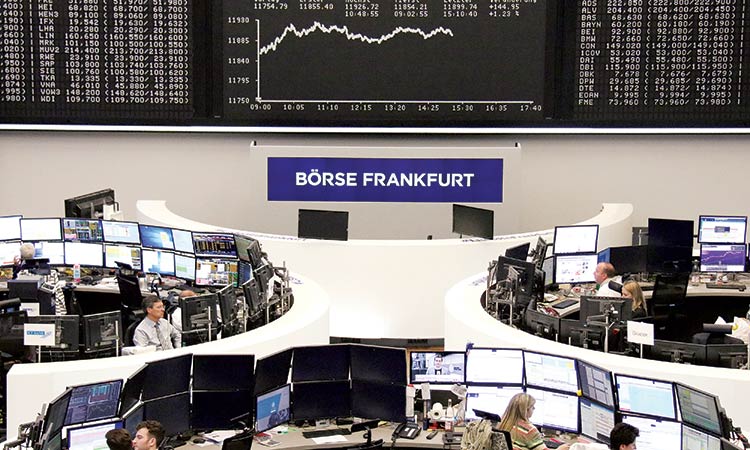Bonds ‘on fire’ as flight to safety gathers momentum

The German share price index DAX graph is pictured at the stock exchange in Frankfurt. Reuters
After a torrid May that wiped $3 trillion off global equities, the worsening trade tensions and broader economic backdrop made for a jarring start to June.
European shares and Wall Street futures both fell further after Beijing sent another shot across Washington’s bows on trade and then eurozone data came in weak, though the main groundswell was in bonds.
German government bond yields − which move inversely to price − fell to a new all-time low and those on two-year US Treasuries were trying for their biggest two-day fall since October 2008, when the global financial crisis was kicking off.
“Bonds are more or less on fire and I think we are going to spend the week with trade dominating everything else,” said Societe Generale global strategist Kit Juckes.
With German and UK political concerns and worries about Italy’s finances resurfacing too, “it is hard to think the yen is not going to be at least one of the winners this week,” he said.
The Japanese currency consolidated Friday’s biggest one-day jump in over two years at 108.40 yen per dollar, though Europe’s go-to safety play, the Swiss franc, kept the rally going by scoring a near 2-year high against the euro.
The euro, for its part, hovered at $1.1176 having been stuck in one of its tightest ranges ever against the dollar for weeks and waiting to see how generous the European Central Bank will be with a new tranche of cheap funding this week.
Asian stocks had fared slightly better overnight as gains in South Korea and India offset a 4-1/2 month low for Tokyo’s Nikkei. Chinese shares ended little changed though the yuan faced pressure.
A private survey of China’s manufacturing sector published on Monday suggested a modest expansion in activity as export orders bounced from a contraction.
Economists noted increases in new export orders pointed to possible front-loading of US-bound shipments to avoid potential tariff hikes that US President Donald Trump - who kicked off a potentially confrontational state visit to Britain on Monday - had threatened to slap on another $300 billion of Chinese goods.
“Many firms are leaving China for other countries, including the US in order to avoid paying the tariffs,” Trump said on Twitter shortly after landing in Britain. “No visible increase in costs or inflation, but US is taking billions.”
With the bitter trade mood weighing, factory activity contracted in most Asian countries and the eurozone last month, surveys showed.
The euro zone’s slowdown was for the fourth month running, and at an accelerating pace, as slumping automotive demand, Brexit and wider political uncertainty took their toll.
“The sector remains in its toughest spell since 2013,” said Chris Williamson, chief business economist at IHS Markit.
A senior Chinese official and trade negotiator had said on Sunday the United States could not use pressure to force a trade deal, refusing to be drawn on whether the leaders of the two countries would meet at the G20 summit at the weekend.
The standoff between the world’s two largest economies goes beyond trade, with tension running high ahead of the 30th anniversary of a bloody Chinese military crackdown on protesters around Beijing’s Tiananmen Square.
China’s Defence Minister Wei Fenghe warned the United States not to meddle in security disputes over Taiwan and the South China Sea, after acting US Defence Secretary Patrick Shanahan said Washington would no longer “tiptoe” around Chinese behaviour in Asia.
“No one now thinks a deal would be possible at the G20. It is going to be a prolonged battle. Investors are rushing to the safe assets,” said Norihiro Fujito, chief investment strategist at Mitsubishi UFJ Morgan Stanley Securities.
The gloomy economic outlook has prompted traders to increase bets that the US Federal Reserve will cut interest rates sooner rather than later.
Fed funds rate futures are almost fully pricing in two rate cuts this year, one by September, with more than a 50 per cent chance of a move by July 30-31.
The 10-year US Treasuries yield fell to as low as 2.07%, a level last seen in September 2017 while bond market volatility gauges have now spiked to the highest in more than two years.
It was lively in commodity markets too.
Brent oil futures tumbled almost 2% to $60.55 per barrel before pulling all the way back up to $62.55. They have dropped almost 20% since April, a plunge classed as a ‘bear market’ in trader parlance.
Another bashing for industrial metals sent Shanghai Copper to a 2-year low as safe-haven gold jumped to a 10-week high of $1,316 per ounce.
Reuters







